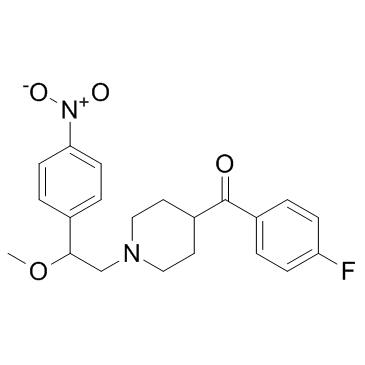| Description |
Telomerase-IN-1 is a Telomerase inhibitor with an IC50 of 0.19 μM.
|
| Related Catalog |
|
| Target |
IC50: 0.19 μM (Telomerase) [1]
|
| In Vitro |
Our in vitro studies show that title compound (Telomerase-IN-1) has high inhibitory activity against telomerase and high antiproliferative capacity on SMMC-7721 cells, and has no obvious toxic effect on human normal hepatocyte cells. Telomerase-IN-1 treatment decreases the growth of cancer cells in dose- and time-dependent manners; however, the viability of L-02 shows slight changes in the compound at 10 μM. 48 h of SMMC-7721 cell treatment with the Telomerase-IN-1 (20, 40, and 80 nM) causes increase of apoptosis. Forty-eight hours of SMMC-7721 cell treatment with the Telomerase-IN-1(20, 40, and 80 nM) causes significant accumulation of green fluorescence, indicating a decrease in MMP. At 40 nM, Telomerase-IN-1 significantly increases expressions of cyt-c and Bax, but the Bcl-2 level is decreased[1].
|
| In Vivo |
Our in vivo studies show that this compound (Telomerase-IN-1) significantly inhibits tumor growth in xenograft tumor models. Results show that endoplasmic reticulum stress (ERS) through ER over response (EOR) activates the expression of hTERT, and then induces ERS, which is believed to be intricately associated with oxidative stress and mitochondrial dysfunction, resulting in apoptotic cell death, thereby modulating the expression of downstream signaling molecules including CHOP (CAAT/enhancer-binding protein homologous protein)) and mitochondrion pathway of apoptosis, leading to inhibition of cell proliferation[1].
|
| Cell Assay |
The effect of the title compound (Telomerase-IN-1) on the viability of human hepatoma cancer cell (SMMC-7721) is examined by increasing concentrations (3.2, 16, 80, 400, and 2000 nM). A normal liver cell line (L-02) is used as control. Cell viability is measured by MTTassay at 48 h[1].
|
| Animal Admin |
To test whether the Telomerase-IN-1 shows any antitumor effect in vivo, SMMC-7721 cells are xenografted into nude mice, and then the tumor-bearing animals are treated with the Telomerase-IN-1 (25, 50, and 100 μM/daily) for 37 days by intraperitoneal injection[1].
|
| References |
[1]. Cheng X, et al. Discovery of (4-bromophenyl)(3-hydroxy-4-methoxyphenyl)methanone through upregulating hTERT induces cell apoptosis and ERS. Cell Death Dis. 2017 Aug 24;8(8):e3016.
|
